The importance of FIRE safety in Residential Solar “Electric” Installations? (Click here for the Commercial Version)
If you are considering a “Solar PV” installation on your home, has your consultant or supplier advised you on the difference between having full fire safety or having very little?
DC (direct current) faults are the primary cause of fires in Solar PV systems. If you install inverters with no DC isolation or Arc detection/Management built-in, you probably have NO fire protection or preventive management system for the biggest root cause of Solar PV fires.
A DC fault that could cause a fire should be detectable months in advance if it is a DC cabling weakness. This fault can occur during the system installation or during a storm that weakens a DC fire risk over time.
As with all HONE Renewable Electricity systems, Arc Detection, Insolation Detection and ongoing Management of all Inverter functions in real-time ensure maximum safety of all systems.
Q1: Should I install the panels over the roof slates/tiles or use plastic panel inserts and embed them in the roof?
As in both UK fires shown in the picture above in the first & third photos, the solar panels were inserted in the roof into plastic-type inserts; therefore, there was NO roofing product behind the panels (slate, concrete tile, etc.) where the fire originated. In addition, embedded plastic roof inserts can provide free fuel for the fire and help it spread quickly and enter the attic and roof timbers. A slate or concrete tile roof could have prevented much damage in this case.
Q2: What fire prevention measures should I insist having on my installation?
See the checklist and explanation further down the page for greater detail. You should insist that your inverter (s) have (AFDM) Arc Fault Detection and Management and automatic shutdown for Arc faults (these faults will show up as insulation faults months before a fire and may be present from the installation on day one). A premium inverter and management package will act as your fire safety system.
Q3: I assume that fire safety is a mandatory requirement for my power inverters as I am placing them within my building?
Unfortunately, not so much as you might think. The primary function of an inverter is to convert DC to AC electricity, and the inverter will be tested and certified to do that safely, but only within the inverter itself. Specialist features and functionality, such as management platforms, arc detection and protection, and live 24/7 opex and maintenance, are all premium functions that provide additional safety on the DC and AC equipment “outside” the inverter and are only found on the best premium inverter equipment.
| CHECKLIST FOR INVERTER FUNCTIONALITY FOR FIRE PREVENTION |
|
| Insulation Resistance Monitoring (Inverter Function) |
This is a function of monitoring the DC cabling system and the earthing outside the inverter. This is an additional non-standard fire safety function of premium inverters and is there to detect inadequate installation of DC cabling and/or new faults that occur over time. These faults can eventually turn into fires if left uncorrected, but in this case, they will shut down the inverter and force you to correct the issue well before any fire risk. These faults can result from the installation, mismatched DC connector fittings or poor assembly of the DC cables. Always ensure that the total system package comes from only one supplier. All HONE systems come with this functionality as standard. |
| Management & Reporting (Inverter Function) |
An inverter should have a reporting function that automatically alerts you to any issues in your system, both inside and outside the inverter itself. All HONE systems come with this as standard. |
| Arc Fault Detection (Inverter Function) |
If you place Solar PV power electronics in or around your building, Arc Fault Detection is like having your own fireman on site. It is designed to stop the risk of fire before it can happen and shut down the inverter, and isolate the DC supply. You should not get to this point if you have Insulation Resistance Monitoring. However, you may have an immediate failure of a DC connector or animals/rodents, which eat into cables and cause an arcing fault. The inverter with AFDM will shut everything down instantly for safety and isolate the DC supply. All HONE systems come with this functionality as standard. |
| INSTALLATION CHECKLIST FOR FIRE PREVENTION |
| Have all the parts for the installation, including all DC & AC electrical components, come from the same source? |
This ensures all electrical components are high quality, compatible and won’t leak or allow water ingress. |
| Has your inverter got a long warranty, 15 or 20 years? |
The inverter is a high-cost component in the system; inverters with short warranties that are low cost don’t generally have a lot of functionality. Your exact inverter model is also unlikely to be available when the warranty period is over, and a full re-design of the system will be necessary to get it running again. |
| Has your system installer a full-string design plan for your system from the supplier? |
You need to store this electrical plan for the future; it will be needed to fix, diagnose or upgrade/repair your system. |
| Is the supplier and/or manufacturer providing you with direct, full online and system support for the duration of the warranty period (free) |
These systems are complex, and you should have supplier and/or manufacturer product support for the life of your system should you request it. If your system stops working in year 3, what do you do ? The existing installer may no longer be in business; where do you go? Who holds your warranties for the system, or did they die with the installer? |
| If you believe that once your Solar PV installation is installed, you can sit back and watch the money roll in for the next 30 years, you may be in for a shock. The following systems below from Ireland and the UK have been screenshots from the public internet. These are a small sample from 1/2/2024, but today, thousands of systems show similar worrying issues.
We do not know what equipment is used in the systems below, but the issues are obvious. There are various issues; reduced annual performance is a big worry for damaged DC cabling or panels. System dead could be a shutdown or failure of the inverter. If your inverter only has a five-year warranty, there is a reason.
Many of these installations have been allowed to run in circumstances that needed investigation and could be deemed high fire risk. Always ensure you have the best power electronics installed in or around your building. Yes, it will be more expensive equipment, and it is designed to stop your building from having a Solar PV fire in the first place.
Based on the data below, all of these systems, whichever make or brand, were bad investments and should have had maintenance interventions. As reported recently, tens of thousands of solar installer companies have exited business in the UK, meaning the warranties on systems like this probably went with them.
But why haven’t the systems below been fixed and repaired? – the main reason is cost and liability. The cost is generally a new system, the customer has lost confidence and no installer is interested in repairing or taking responsibility for a solar system that has failed and whose warranties have expired or the manufacturer won’t validate them any longer.
Make sure the manufacturer of your system is a partner with your installer, will honour and support your long term warranties throughout the journey or your renewable investment may never be realised and could be a total waste of money.
All HONE systems are kitted completely by HONE and delivered as full packages to our partner installers. This ensures we can support your system throughout its operating life and protect your investment with long warranties regardless of what happens to the installer. |
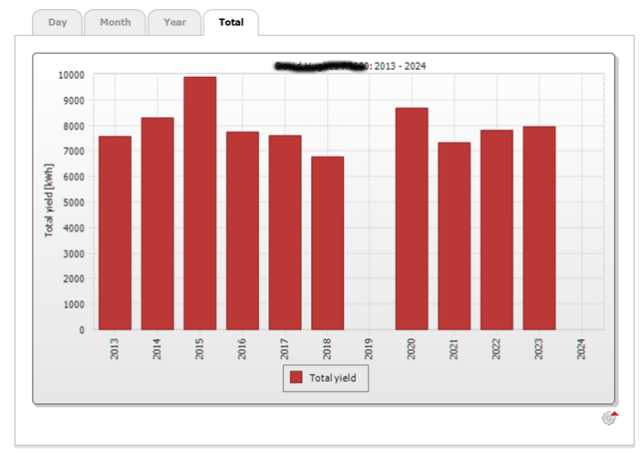 |
 |
 |
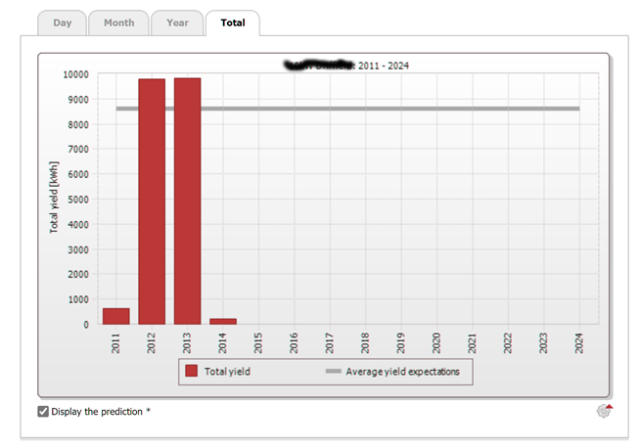 |
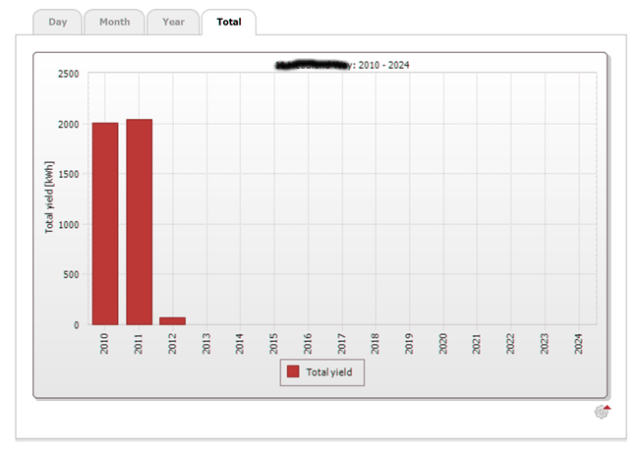 |
 |
 |
 |
 |
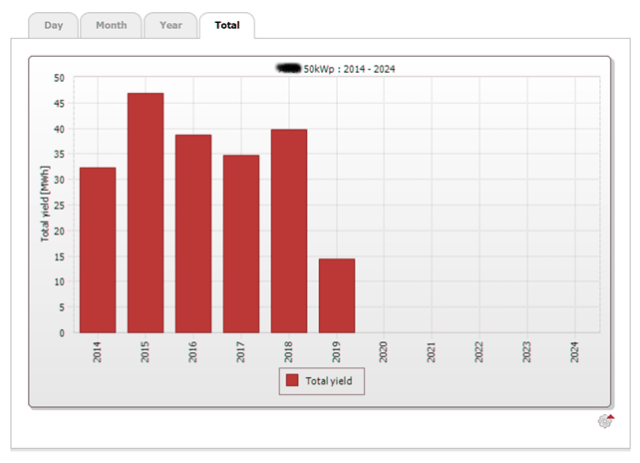 |
 |
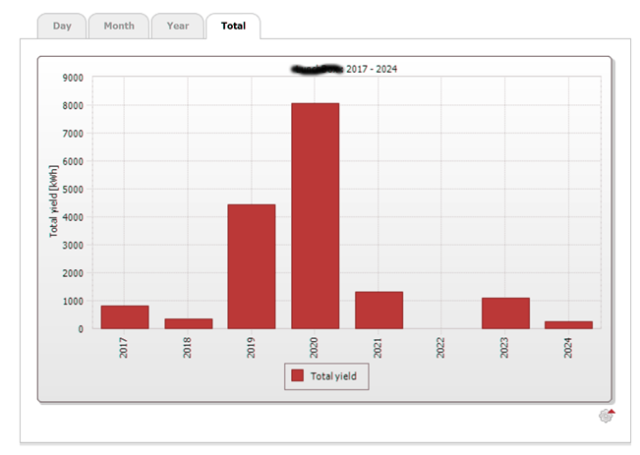 |
| This is what a system’s output performance should look like. Each year should be nearly the same as the last (except year one, which will be a part-year).
But manufacturer warranties must back it up, or your investment may be well-intentioned but never realised. |
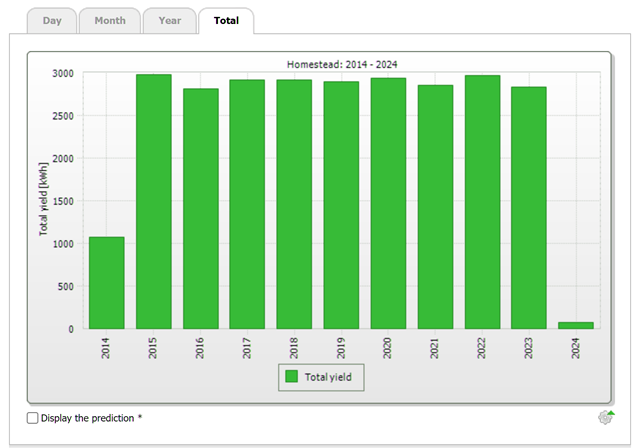 |
















